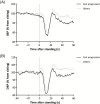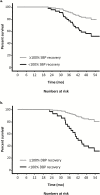Orthostatic Blood Pressure Recovery Is Associated With the Rate of Cognitive Decline and Mortality in Clinical Alzheimer's Disease
- PMID: 32449919
- PMCID: PMC7566323
- DOI: 10.1093/gerona/glaa129
Orthostatic Blood Pressure Recovery Is Associated With the Rate of Cognitive Decline and Mortality in Clinical Alzheimer's Disease
Abstract
Background: Impaired recovery of blood pressure (BP) after standing has been shown to be related to cognitive function and mortality in people without dementia, but its role in people with Alzheimer's disease (AD) is unknown. The aim of this study was to investigate the association of the orthostatic BP response with cognitive decline and mortality in AD.
Methods: In this post hoc analysis of a randomized controlled trial (Nilvad), we measured the beat-to-beat response of BP upon active standing in mild-to-moderate AD. This included the initial drop (nadir within 40 seconds) and recovery after 1 minute, both expressed relative to resting values. We examined the relationship between a small or large initial drop (median split) and unimpaired (≥100%) or impaired recovery (<100%) with 1.5-year change in Alzheimer's Disease Assessment-cognitive subscale (ADAS-cog) scores and all-cause mortality.
Results: We included 55 participants (age 73.1 ± 6.2 years). Impaired BP recovery was associated with higher increases in ADAS-cog scores (systolic: β [95% confidence interval] = 5.6 [0.4-10.8], p = .035; diastolic: 7.6 [2.3-13.0], p = .006). During a median follow-up time of 49 months, 20 participants died. Impaired BP recovery was associated with increased mortality (systolic: HR [95% confidence interval] = 2.9 [1.1-7.8], p = .039; diastolic: HR [95% confidence interval] = 5.5 [1.9-16.1], p = .002). The initial BP drop was not associated with any outcome. Results were adjusted for age, sex, and intervention group.
Conclusions: Failure to fully recover BP after 1 minute of standing is associated with cognitive decline and mortality in AD. As such, BP recovery can be regarded as an easily obtained marker of progression rate of AD.
Keywords: Alzheimer’s disease; Blood pressure; Continuous monitoring; Dementia; Resilience.
© The Author(s) 2020. Published by Oxford University Press on behalf of The Gerontological Society of America.
Figures



Similar articles
-
Impaired systolic blood pressure recovery directly after standing predicts mortality in older falls clinic patients.J Gerontol A Biol Sci Med Sci. 2014 Apr;69(4):471-8. doi: 10.1093/gerona/glt111. Epub 2013 Jul 20. J Gerontol A Biol Sci Med Sci. 2014. PMID: 23873962
-
Alzheimer's Disease Assessment Scale-Cognitive subscale variants in mild cognitive impairment and mild Alzheimer's disease: change over time and the effect of enrichment strategies.Alzheimers Res Ther. 2016 Feb 12;8:8. doi: 10.1186/s13195-016-0170-5. Alzheimers Res Ther. 2016. PMID: 26868820 Free PMC article.
-
Graded Association Between Kidney Function and Impaired Orthostatic Blood Pressure Stabilization in Older Adults.J Am Heart Assoc. 2017 May 4;6(5):e005661. doi: 10.1161/JAHA.117.005661. J Am Heart Assoc. 2017. PMID: 28473404 Free PMC article.
-
Prognosis of diastolic and systolic orthostatic hypotension in older persons.Arch Intern Med. 1999 Feb 8;159(3):273-80. doi: 10.1001/archinte.159.3.273. Arch Intern Med. 1999. PMID: 9989539 Review.
-
Noninvasive beat-to-beat finger arterial pressure monitoring during orthostasis: a comprehensive review of normal and abnormal responses at different ages.J Intern Med. 2017 Dec;282(6):468-483. doi: 10.1111/joim.12636. Epub 2017 Jul 10. J Intern Med. 2017. PMID: 28564488 Review.
Cited by
-
Network Physiology in Aging and Frailty: The Grand Challenge of Physiological Reserve in Older Adults.Front Netw Physiol. 2021 Jul 7;1:712430. doi: 10.3389/fnetp.2021.712430. eCollection 2021. Front Netw Physiol. 2021. PMID: 36925570 Free PMC article. No abstract available.
-
Preoperative physical resilience indicators and their associations with postoperative outcomes.Geroscience. 2025 Jun;47(3):4857-4870. doi: 10.1007/s11357-025-01633-6. Epub 2025 Apr 2. Geroscience. 2025. PMID: 40175848 Free PMC article.
-
Long-term antipsychotic use, orthostatic hypotension and falls in older adults with Alzheimer's disease.Eur Geriatr Med. 2024 Apr;15(2):527-537. doi: 10.1007/s41999-023-00910-x. Epub 2024 Jan 2. Eur Geriatr Med. 2024. PMID: 38168729 Clinical Trial.
-
Safety and feasibility of transcutaneous vagus nerve stimulation in mild cognitive impairment: VINCI-AD study protocol.BMC Neurol. 2023 Aug 2;23(1):289. doi: 10.1186/s12883-023-03320-5. BMC Neurol. 2023. PMID: 37532979 Free PMC article. Clinical Trial.
-
Associations of Orthostatic Hypotension and Frailty With Dementia and Mortality in Older Adults: A Population-Based Cohort Study.J Gerontol A Biol Sci Med Sci. 2024 Apr 1;79(4):glae010. doi: 10.1093/gerona/glae010. J Gerontol A Biol Sci Med Sci. 2024. PMID: 38195215 Free PMC article.
References
Publication types
MeSH terms
Substances
LinkOut - more resources
Full Text Sources
Medical
Research Materials

